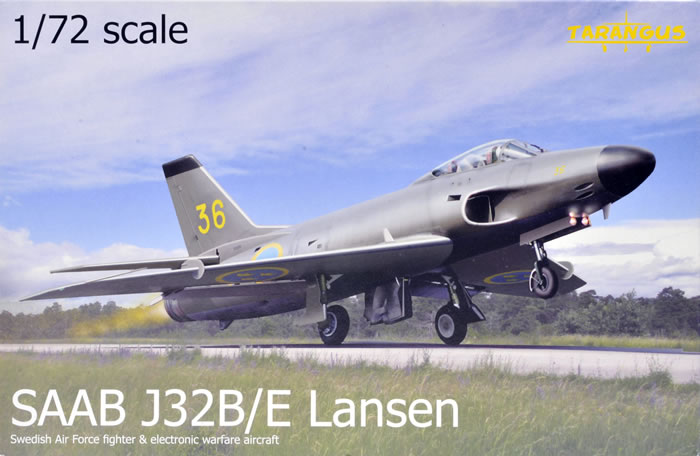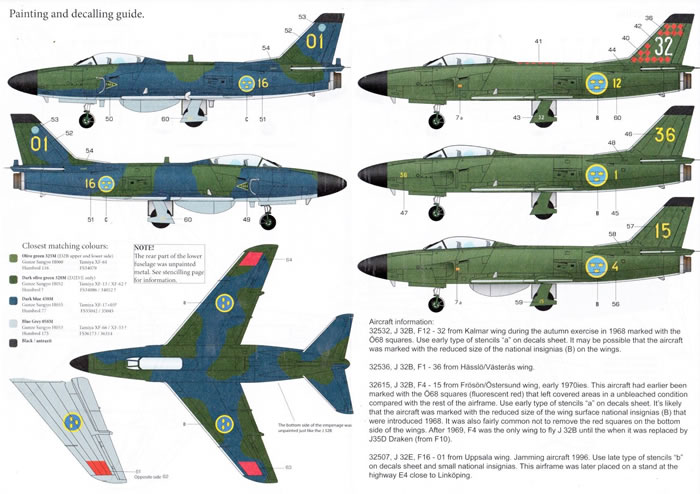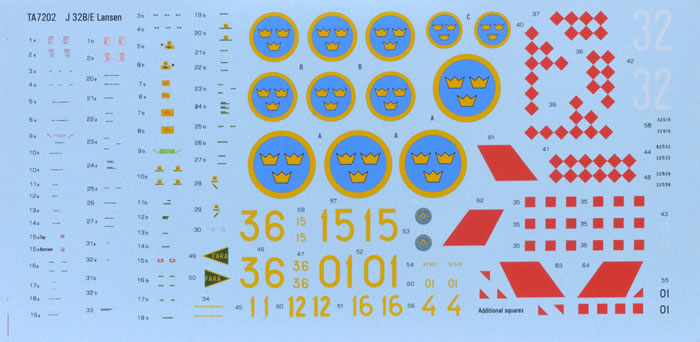|
SAAB J.32B/E Lansen

Tarangus, 1/72 scale
S u m m a r y : |
Catalogue Number: |
Tarangus Kit No. TA7202 - SAAB J.32B/E Lansen |
Scale: |
1/72 |
Contents & Media |
71 and four clear styrene parts, and decals for four subjects. |
Price: |
Available online from:
|
Review Type: |
First Look |
Advantages: |
Covers the J.32B & E variants, refined surface detail, very good decals. |
Disadvantages: |
Closed airbrakes, no ECM stores. |
Conclusions: |
This is a modest advance over the 34 year old Heller Lansen. It at least covers different versions to compliment the A&C variants offered by the French kit.
In my opinion, the lack of deployed airbrakes is major omission that really lets the kit down.
For its price, I think that the kit should have included photo-etched airbrakes and some ECM stores for the J.32E option.
Despite my doubts about value for money, I recommend it because it enables a J.32B or E to be built from the box for about the same price as converting the Heller kit using Maestro Models’ conversion set, whilst some detail benefits and better decals give it a slight advantage over the conversion option. |
Reviewed by Mark Davies

Valom's 1/48 scale An-2 Colt is available online from Squadron.com
In late 1946, Saab began internal studies aimed at developing a replacement aircraft for the Saab B 18/S 18 as Sweden's standard attack aircraft. In 1948, Saab was formally approached by the Swedish Government with a request to investigate the development of a turbojet-powered strike aircraft to replace a series of 1940s vintage attack, reconnaissance and night-fighter aircraft then in the Flygvapnet: the B 18/S 18, J?21R/A 21R and J 30 (de Havilland Mosquito). Out of several differing design studies performed, including a twin-engine aircraft intended to be powered by a pair of de Havilland Ghost turbojet engines, Saab settled on a single-engine design, which was initially designated the P1150.
On 20 December 1948, a phase one contract for the design and mock-up of the proposed aircraft was issued, formally initiating development work upon the P1150. The requirements laid out by the Swedish Air Force for the P1150 were demanding: it had to be able to attack anywhere along Sweden's 2,000?km of coastline within one hour of launch from a central location. It had to be capable of being launched in any weather conditions and at day or night. In response, Saab elected to develop a twin-seat aircraft with a low-mounted wing, and equipped with advanced electronics. The P1150 would break new grounds for the Swedish Air Force, being their first two-seat jet aircraft, and the first to carry a built-in search radar.

Saab had initially envisaged powering the P1150 with the indigenously produced STAL Dovern turbojet engine. However, both timescale and technical difficulties encountered during the development of the Dovern resulted in the Swedish government electing to substitute the intended Dovern engine with the license-built Rolls-Royce Avon Series 100 turbojet engine, designated RM.5, instead. The single Avon engine provided the Saab A.32A with a thrust to weight ratio of about 0.3, and enabled the aircraft to be roughly 10,000lb heavier than the twin engine Saab 18 it replaced; the later-produced J.32B interceptor and S.32C reconnaissance variants received the upgraded and significantly more powerful RM6A Avon engine instead.
On 3 November 1952, the first P1150 prototype conducted its first flight. The design of the prototypes had initially featured both Fowler flaps and a leading edge slot; this slot was discarded as unnecessary after trials with the prototypes and never appeared on subsequent production aircraft. Triangular fences were added near the wing roots during flight testing in order to improve airflow when the aircraft was being flown at a high angle of attack. A small batch of P1150 prototypes completed design and evaluation trials with series production of the newly designated Saab 32 Lansen beginning in 1953. Development work on the project was recorded as having involved more than 2,000,000 man-hours in total.
In Development 1955, the first production A.32A Lansen attack aircraft were delivered to the Swedish Air Force; deliveries of this variant proceeded through to mid 1958, at which point manufacturing activity switched to the other two variants of the Lansen, the J.32B and S.32C. These two models differed substantially from the first, the J.32 B being fitted with a new engine for greater flight performance along with new navigation and fire control systems. On 7 January 1957, the first J.32 B Lansen conducted its maiden flight; on 26 Match 1957, the first S.32C Lansen performed its first flight. Production of the Lansen continued until May 1960.
The J.32B was an all-weather fighter version initially operated only for bad weather and night fighter duties. Two prototypes and 118 production aircraft built between 1958 and 1960, retired in 1973. Armed with four 30 mm ADEN guns, Rb 24 missiles (license-built AIM-9 Sidewinder), or 75 mm unguided rocket pods, the J.32B was powered by a more powerful Svenska Flygmotor RM 6A (Rolls-Royce Avon Mk 47A) engine.
The J.32E was an electronic warfare and countermeasures (ECM) version also used for ECM training. Fourteen J.32B were modified to J.32E standard, and retired in 1997. The aircraft was equipped with jamming system G 24 in one of three versions (for L, S or C bands) used for jamming ground and naval radars. Additionally Adrian (for S and C bands) and Petrus (for X band) pods were used for jamming aerial radars.
Source: Wikipedia
Previous 1/72 scale Lansens
Beauty is in the eye of the beholder, but I think many would agree that the Lansen is a handsome and interesting design that has been rather overlooked by kit makers. This is probably in largely due to it only ever having a single small air force operator.
I am only aware of one previous Lansen kit in The One True Scale, and that is this classic Heller kit which covers the ‘A’ attack and ‘S’ reconnaissance versions (A.32A & S.32C respectively). Like many Heller offerings from the early 1980s, this is still a good kit. I built one 12 years ago when I converted it to a J.32B, scratch-built the airbrakes, and re-scribed the quite fine raised surface detail. As I recall everything fitted very well. The kit has a couple of failings; the air-brakes are moulded shut when they should always be deployed with the undercarriage down, and the optional but very characteristic external belly tank is not supplied. Its weak points are the absence of any underwing stores and often poor quality decals (in early boxings in particular).
I have seen mention of a full A.32 Lansen kit by AA Models, but can find no details whatsoever about it.
Although not a kit, I should just mention that Maestro Models produces a resin J.32B conversion for the Heller kit, which provides the open 30mm cannon blast troughs, new afterburner nozzle and belly tank.
The kit appears to have been produced by Sword as the sprues and instructional format bear a very strong resemblance to this brand's products, or at least by the same injection moulder that Sword uses if they contract out.
The kit comes in an end-opening box with digital artwork on the front and three colour profiles on the rear. The instructions provide a parts map, and an easy to follow diagrammatic assembly format in the same style as Sword’s kits. There is also a brief history of the aircraft. All text is in English. Painting and decal guides are printed in colour with some useful notes covering likely markings characteristics. Paint colours are cross-referenced to FS 595, and paint ranges from Humbrol, Gunze Sangyo and Tamiya. This is a big improvement compared to the Tarangus SAAB J 29 I reviewed about three years ago. A two-page, four-view stencil placement guide is also provided.
The two main sprues come in a zip-lock bag, with clear parts and decals further protected in their own bags.
Although of limited run nature, all parts are well moulded with very fine and crisp surface detail. The parts break down is conventional, with narrow sprue gates. Some flash is visible in some places, particularly the combined nose wheel and leg, but this can be easily dealt with. There are some prominent ejector pin marks that, with one exception, do not interrupt moulded detail.
The Kit
The cockpit detail is reasonable, representing a modest advance on Heller’s kit. Seat harness and firing handle detail really needs to be added, either scratch-built or courtesy of Maestro Models PE detail set. Clear panels that fit either side of the seat headrests and a clear blast-screen for between the seats are provided. The single piece windscreen and canopy is nice and clear.

A reasonably well detailed nose-wheel bay fits beneath the cockpit sub-assembly, and there is an insert that fits some way behind the cockpit to provide main wheel bay detail (marred somewhat by ejector pin marks). Both nose and main wheel well detail is quite an improvement over the Heller kit’s. Unfortunately, the same cannot be said of the main wheels, which have some slight out-of-round distortions to the hubs and off-centre rims. I feel resin wheels would have been a better option. The prominent pair of landing lights that fit in the nose wheel bay are moulded in grey styrene, where clear would seem to have been a better choice; but this is small issue.
As with Sword kits, the instructional drawings sometimes illustrate the parts as having more detail than is actually moulded. This is the case with the tail-bumper and exhaust nozzle, which if made from resin could have captured the detail missing from the injected parts.
The air intakes are nicely done with extended intake trunking included with the boundary layer splitter plates. This longer trunking is an improvement on the Heller kit’s, which is quite short.
The fuselage halves enclose the cockpit, wheel well, and afterburner sub-assemblies. The model will need some nose ballast added as well (something the instructions fail to mention). There are some small scoops to add to the dorsal fuselage, again drawn far better than they are moulded; in fact, they would have to be cast in resin to look as good as the instructional drawings, given the kit’s limited run tooling constraints.
There are several blade antennae to fit to the fuselage, but be careful of simply following the instructions as these fail to advise which are only applicable to the J.32E ECM variant; the painting guide gives a better indication of the differences in antennae locations.
Some may wish to improve the definition of the cannon blast troughs which are rather shallow and fail to penetrate the fuselage due to tooling limitations. Fortunately, and unlike Heller, Tarangus include the external belly tank. The horizontal and vertical stabilizers are all that is needed to finish the fuselage off.
The wings are straightforward with quite fine trailing edges. They have separate small wing fences and what appear to be blade antennae inboard near their roots. The wingtip pitot is again illustrated as a more refined item than that supplied, and is best replaced with a scratch-built or aftermarket item by Maestro or Master.
Four underwing stores pylons are provided, two with Rb 24 missile rails fitted. The only stores supplied are a pair of Rb 24s (AIM-9 Sidewinder). This is disappointing, as it would have been nice to have had a Petrus/Adrian jamming pod and a BOZ 3 chaff dispenser for the E variant (both available from Maestro Models), as well as additional stores pylons.
The kit matches the Heller kit perfectly in outline and dimension, except for (and correctly) the area around the exhaust nozzle where the B/E differs from the A/C variants. This unsurprising as no doubt a re-scribed Heller kit formed the basis of the master. I have never read of any criticism of the Heller kits outline accuracy, so this is a good thing. I am aware that the B/E variant did have slightly modified air intakes from the A/C to feed the more powerful engine; although I have yet to determine what and how significant in appearance the difference is.
The biggest and in my opinion unforgivable omission with this kit is that there is no option for deployed airbrakes. The Lansen has four distinct airbrakes that extend from the fuselage behind the wing when the undercarriage is lowered. Yes, the Heller kit has the same problem, but it is a French company’s product from 34 years ago, whilst Tarangus is a modern Swedish concern offering a fairly expensive kit - It costs more than double the price of similar Sword kit like the F3D Skyknight, which is a similar size and also lacking PE or resin detail parts.
Fortunately, Maestro Model’s Lansen A/C detail set for the Heller kit has the deployed airbrakes, and will suit the Tarangus kit equally well. The downside is that this is an expensive set, costing around half the Tarangus kit’s price.
Had this been a Sword branded kit I think it would either be slightly less than half the price for a kit of the same standard; or cost almost as much, but have included deployed airbrakes and other PE details, and possibly some resin parts too. I do not mean to be harsh, but it seems Tarangus’s current business means their kits will be comparatively expensive compared to equivalent Czech-branded ones, as presumably there is an extra level of margin involved.
Some good news from a build review I read is that the kit assembles with few problems, although a little filler was required along the wing to fuselage join and to blend the canopy in.
Colours & Markings
Four decal options are provided, three J.32Bs and one J.32E, as shown below:

The decals are printed very nicely, and look to be very good quality. They include extensive stenciling and include the red panels and checkers applicable to two of the options.

I have read that the decals perform very well when applied
Wisely, Tarangus chose to offer the J.32B & E to compliment the Heller kits’ options of the A & C variants, although the Heller kit is easily converted to a J.32B/E using the Maestro Models conversion. I was very hopeful that their 1/72 scale offering would be distinct advance on the Heller kit.
When comparing the Tarangus and Heller Lansens the new kit offers nice recessed panel lines in place of the older kit’s fine raised detail, marginally better cockpit detail, superior wheel well detail (that is diminished by misshapen main wheels), a belly tank, two Sidewinders, and vastly superior decals. Sadly, this is not as much of an advance in 34 years as I hoped for, especially when the new kit costs around two to four times as much as the Heller kit does second hand.
The Tarangus J32B/E costs a little more than converting the Heller kit to a B or E variant using a Maestro Models conversion; but has the advantage of recessed panel lines and fractionally better internal detail. This makes sense, and I can recommend it on this basis.
But if to build the Lansen with its wheels down correctly will cost half as much again to fix the lack of airbrakes, or they must be scratch-built; whilst a J.32E will look a bit bare without jamming pods etc, which again implies additional expenditure. These are things that a modern kit at this price should have included in my opinion.
Had Tarangus included deployable PE airbrakes with the kit then I would be declaring all is well, and that the new kit is indeed a major advance on Heller’s. As things stand, Tarangus has definitely bettered the Heller kit, but at a price premium that brings its value into question.
Thanks to Tarangus for the review sample.
Review Text Copyright © 2016 by Mark Davies
Images Copyright © 2016 by Brett Green
Page Created 25 July, 2016
Last updated
26 July, 2016
Back to HyperScale Main Page
Back to Reviews Page

|
